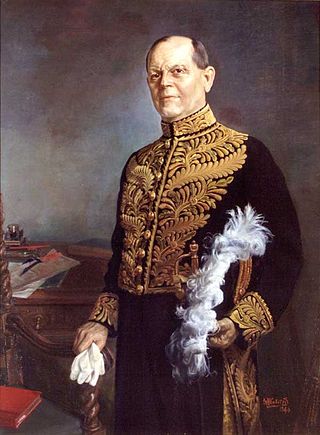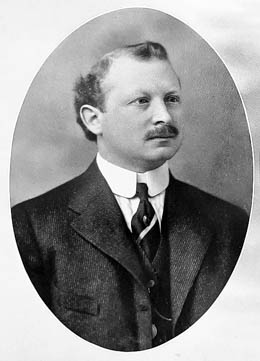
The Royal School of Needlework (RSN) is a hand embroidery school in the United Kingdom, founded in 1872 and based at Hampton Court Palace since 1987.

Lace is a delicate fabric made of yarn or thread in an open weblike pattern, made by machine or by hand. Generally, lace is divided into two main categories, needlelace and bobbin lace, although there are other types of lace, such as knitted or crocheted lace. Other laces such as these are considered as a category of their specific craft. Knitted lace, therefore, is an example of knitting. This article considers both needle lace and bobbin lace.

Bedworth is a market town in the borough of Nuneaton and Bedworth, Warwickshire, England. It is situated between Coventry, 6 miles to the south, and Nuneaton, 3 miles (5 km) to the north.

A shirt is a cloth garment for the upper body.

A ribbon or riband is a thin band of material, typically cloth but also plastic or sometimes metal, used primarily as decorative binding and tying. Cloth ribbons are made of natural materials such as silk, cotton, and jute and of synthetic materials, such as polyester, nylon, and polypropylene. Ribbon is used for useful, ornamental, and symbolic purposes. Cultures around the world use ribbon in their hair, around the body, and as ornament on non-human animals, buildings, and packaging. Some popular fabrics used to make ribbons are satin, organza, sheer, silk, velvet, and grosgrain.

A button is a fastener that joins two pieces of fabric together by slipping through a loop or by sliding through a buttonhole.

Mess dress uniform is the most formal type of evening-wear uniform used by military personnel, police personnel, and other uniformed services members. It frequently consists of a mess jacket, trousers, white dress shirt and a black bow tie, along with orders and medals insignia. Design may depend on regiment or service branch, e.g. army, navy, air force, marines, etc. In modern Western dress codes, mess dress uniform is the supplementary alternative equivalent to the civilian black tie for evening wear. Mess dress uniforms are typically less formal than full dress uniform, but more formal than service dress uniform.

Brother Industries, Ltd. (stylized in lowercase) is a Japanese multinational electronics and electrical equipment company headquartered in Nagoya, Japan. Its products include printers, multifunction printers, desktop computers, consumer and industrial sewing machines, large machine tools, label printers, typewriters, fax machines, and other computer-related electronics. Brother distributes its products both under its own name and under OEM agreements with other companies.

The Jewellery Quarter is an area of central Birmingham, England, in the north-western area of Birmingham City Centre, with a population of 19,000 in a 1.07-square-kilometre (264-acre) area.
The Birmingham pen trade evolved in the Birmingham Jewellery Quarter and its surrounding area in the 19th century; for many years, the city was the centre of the world's pen trade, with most dip pens being produced there. At the height of the Jewellery Quarter's operations, there were about 100 pen factories, which employed around 8,000 skilled craftspeople.

Court uniform and dress were required to be worn by those in attendance at the royal court in the 19th and early 20th centuries.
United States Army commissioned officers rank insignia in use today.
The following outline is provided as an overview of and topical guide to crafts:
Events from the year 1685 in England. This year sees a change of monarch.
Gota patti or gota work is a type of Indian embroidery that originated in Rajasthan, India. It uses the applique technique. Small pieces of zari ribbon are applied onto the fabric with the edges sewn down to create elaborate patterns. Gota embroidery is used extensively in South Asian wedding and formal clothes.

Cash's, or J. & J. Cash Ltd., is a company in Coventry, England, founded in 1846, that manufactures woven name tapes and other woven products and is known for formerly making ribbons.
The Chicago Embroidery Company was founded in 1890 by Johannes Bodenmann, who came to the United States from Switzerland and eventually settled in Chicago in the later part of the nineteenth century. He used his lace making skills and knowledge to form the company, which was formally incorporated in 1894.

Congleton, Macclesfield, Bollington and Stockport, England, were traditionally silk-weaving towns. Silk was woven in Cheshire from the late 1600s. The handloom weavers worked in the attic workshops in their own homes. Macclesfield was famous for silk buttons manufacture. The supply of silk from Italy was precarious and some hand throwing was done, giving way after 1732 to water-driven mills, which were established in Stockport and Macclesfield.
Thomas Fattorini Ltd is a manufacturing jeweller and designer-maker of awards, trophies, ceremonial swords, civic insignia, medals and name badges. The company is located on three sites in Manchester, Birmingham and London with their head office in Skipton, North Yorkshire.

Robert Reiner was a machinist, entrepreneur and businessman. At the time of his birth, Württemberg was an independent kingdom located in a region of Germany known as Swabia. Swabia has a unique culture and Alemannic dialect. His business is credited with helping to expand the machine embroidery industry in Hudson County, New Jersey during the first half of the twentieth century. By the 1950s, the area known as North Hudson comprising the municipalities of Weehawken, Union City, West New York, Guttenberg, and North Bergen had developed into one of the largest centers for machine embroidery in the world. Reiner first traveled to the United States about 1902. He first installed and then began importing embroidery and other textile machines from Europe. He established what became Robert Reiner Incorporated in Weehawken. Eventually he employed about 200 people. He was the sole importer of VOMAG embroidery machines from Plauen, Germany. Eventually he produced the first American made schiffli embroidery machine. Reiner held an honorary doctorate of political economy and science from the University of Heidelberg. He remained a benefactor of his native Nürtingen. He was a member of the US Chamber of Commerce, the New York Board of Trade, and was president of the American-German Chamber of Commerce until World War II. In October 1928 he was one of twenty passengers aboard the Graf Zeppelin during its first trans Atlantic commercial passenger flight, flying from Friedrichshafen, Germany to Lakehurst, New Jersey.














